A Beginner’s Guide to the MOSFET
September 6, 2011 90 Comments
If you need to switch high current and or high voltage loads with a micro controller you’ll need to use some type of transistor. I’m going to be covering how to use a MOSFET since it’s a better option for high power loads. This guide will be just a brief introduction that will discuss how to drive a MOSFET in a simple manner with the ultimate goal of making it act like an ideal switch. I’m not going to get into any of the topics such as Triode region, Saturation, Threshold Voltage, etc…
Refer to the N or P channel basic wiring schematics and remember the three pins: Gate, Drain, and Source. When I mention something like Gate-Source potential difference, I’m talking about the difference in voltage between the two pins.
Thank you Farnell.com for supplying many of the parts that will be part of this review/guide. I wanted to also mention that all parts performed great!
How to think of a MOSFET:
A MOSFET may be thought of as a variable resistor whose Drain-Source resistance (typically Rds) is a function of the voltage difference on the Gate-Source pins. If there is no potential difference between the Gate-Source, then the Drain-Source resistance is very high and may be thought of as an open switch — so no current may flow through the Drain-Source pins. When there is a large Gate-Source potential difference, the Drain-Source resistance is very low and may be thought of as a closed switch — current may flow through the Drain-Source pins.
N channel – For an N channel MOSFET, the source is connected to ground. If we want to let current flow, we can easily raise the voltage on the gate allowing current to flow. If no current is to flow, the gate pin should be grounded.
P channel – Looking at the P channel MOSFET, the source is connected to the power rail V2. In order to allow current to flow the Gate needs to be pulled to ground. To stop the current flow, the gate needs to be pulled to V2. A potential problem is if V2 is a very high voltage it can be difficult raising the gate to the V2 voltage. Not only that, but the MOSFET has limitations on the Gate-Source potential difference. Also note that logic is inverted for a P type MOSFET!
Drain-Source resistance – Ideally we want Drain-Source resistance to be very high when no current is flowing, and very low when current is flowing. The main issue using MOSFETs with micro controllers is that the MOSFET may need 10-15 Gate-Source potential difference to get near its lowest Drain-Source resistance, but the microcontroller may run on 5v or 3.3v. Some sort of MOSFET driver is required.
Gate-Source Capacitance – There is also a capacitance on the Gate-Source pins which prevents the MOSFET from switching states quickly. In order to quickly change voltage on internal capacitance, the MOSFET driver needs to be high current. It needs to actively charge (source) and discharge (sink) the capacitor too (for N channel)!
MOSFET Drivers:
A half bridge is capable of doing what was mentioned above! There are many ICs available which can do this. Here’s a list of just a few that I’ve tested. Schematics are also provided!
- MIC4422YN – Max of 18v, 9Amps peak, 2 Amps continuous.
- MCP1407 – Max of 18v, 6Amps peak, 1.3 Amps continuous.
- UCC27424 – Can drive two MOSFETs, Max of 15v, 4Amps typical.
All of these drivers performed nearly identically (~20ns rise, ~30ns fall). Note that although these can be used for more than just MOSFET drivers, these chips do not have much heat dissipation capabilities!
MOSFETs I’ve tested:
It was originally part of the plan to get some data about these guys, but I have been very busy with school. The MOSFETs have plenty of graphs inside the datasheets!
- IRFP260N – 200v, 50A, N channel.
- IRF3703PBF – 30v, 210A, N channel. Misleading ratings! Read my Datasheet Notes at end.
- RFP30N06LE – 60v, 30A, N channel.
- FQP27P06– 60V, 27A, P channel.
An Important Reminder – Don’t forget that typically the heat sink on the back of a mosfet is connected to the Drain! If you mount multiple MOSFETs on a heat sink, the MOSFET must be electrically isolated from the heat sink! It’s good practice to isolate regardless in case the heat sink is bolted to a grounding frame.
Body Diode – Mosfets also have an internal diode which may allow current to flow unintentionally (see example). The body diode will also limit switching speed. This won’t be a concern if you’re operating below 1mhz.
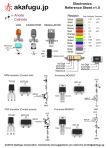
Great cheat sheet, includes MOSFETS. – akafugu.jp
Side note about Gate – Source voltage: MOSFET Gates can go above or under the source voltage. So for an N channel mosfet with a source at 0v, a -10v on the gate would allow current to flow. Verify this with your MOSFET’s datasheet!
Schematic Diode – If the load is somewhat inductive, you’ll need to put a diode to discharge the inductor. If you want more detail, look at the International Rectifier pdf at the end. My “Intro to the Boost Converter” also talks about the nature of inductors when quickly switched on/off.
Gate-Source ringing – There are a few methods that I’ve heard of / seen to limit ringing on the gate. Ringing decreases efficiency, and if excessive, can damage the MOSFET. You can use a zener and resistor in series with the zener’s cathode connected to gate, anode connected to source for N channel. P channel will have the zener flipped. Add a resistor to limit current going through the zener, and watch those breakdown voltages! There is also another diode you could look into called the TVS diode.
Datasheet notes – If a part has too good to be true ratings, check the application notes carefully. For example, the IRF3703PBF claims 210 Amps continuous drain current at 25ºC. We don’t have to do any thermal calculations to know 220 Amps is a TON of current for a TO-220 package! A closer look on page 8, note 6 reveals that it can pass a maximum of 75 Amps continuously due to the package thermal limitations. For future advice: IRF is pretty good at giving accurate ratings, but you have to look for things like this. Now in the real world lots of testing reveals if your design is bad, or if you’re working with a dishonest or incompetent supplier with inaccurate/misleading data sheets.

Without the driver, the Gate takes longer to charge, and it peaks at 5v. Excessive ringing due to no gate ringing suppression.
Great Additional Reading:
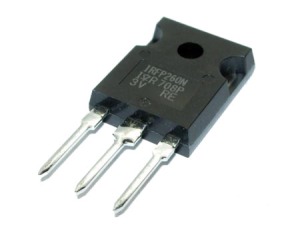
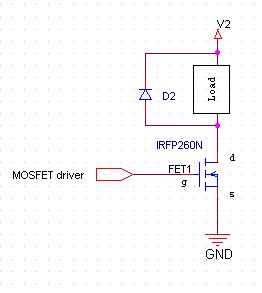
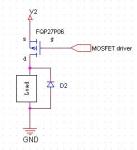
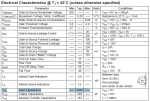
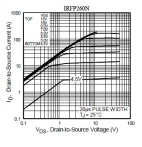






Pingback: Beginner Concepts: MOSFETs - Hack a Day
“Drain-Source resistance: Ideally we want Gate source resistance to be very high when no current is flowing, and very low when current is flowing.” I think you meant to write drain instead of gate here.
Thanks
I am not sure if what whiskthecat is saying is correct. Gate is insulated & it always remains so. So resistance between Gate – Source always remain very high (and that is what is most important & useful property of MOSFET) The Source to Drain channel is formed (& thickness varies) due to electric field of gate. Hence Source to drain resistance varies due to this channel, when a complete thick channel is formed, resistance becomes very low.
In reply to Abhi I was just pointing out a typo of sorts. In the sentence in quotes the word ‘gate’ was meant to be ‘drain’ as that was the topic being discussed in that section. What Moser is saying is that you want the MOSFET to be as little resistance as possible when you switch it on for maximum current and as much resistance as possible when you have it switched off for minimum current just as with an ideal switch. As far as gate to source resistance goes, it is easier to think of gate to source as capacitance since it physically is a capacitor. Meaning that while the MOSFET is in a fully on state then the resistance from gate to source will be high, just as a with a fully charged capacitor minimal current is flowing. But when you first go to turn the MOSFET on the capacitor is empty and an inrush of current comes into the gate-source capacitor in order to charge it up and turn the MOSFET on. Therefore the gate to source resistance is not always high and this is why you see high current MOSFET gate drivers.
@whiskthecat
Yeah probably I didn’t read the meaning correctly :)
And since switching current is large so resistance is not always large (since we take R=V/I)
(Another equation that is of interest here: (sq)Z=(sq)R+(sq)Xc [sq is Square] )
One thing to look for when using MOSFETs with micros (like the Arduino): try to use “logic level” MOSFETs. The Vgs gate voltage for these is usually in the 3 to 5 volt range so you don’t need the driver chip.
Actually, you will still need the MOSFET driver circuit – due to the gate capacitance, if you don’t drive gate with a fairly large current (amps), you’ll get significant turn on/off time that will reulst in a large disipation on the MOSFET.
I don’t think “need” is the right word… MOSFET drivers are definitely helpful, but if you don’t mind the 1us glitch you see in the example (or whatever characteristics the FET you’re using has) then it might not be entirely necessary.
ALSO! It’s very, very important to do the calculation for power dissipation!
Joshua,
You are right. Should have said “might need” :)
In regards to power disipation, it’s very coplex if you don’t drive gate with a large current (short rise/fall time), but if you figure it out during the turn on/off times somhow, then just average it with the low disipation during the “steady state” (on or off).
Power calculation get’s a bit eaiser if driving strictly resistive loads
I would add a few sentences about the following:
body diodes
driving inductive loads and inductive ‘kick’
input capacitance and limiting switching speeds with gate resistors
Hello Moser, nice overview! Only thing to change is that power MOSFET tabs are connected to drain and not gate (if you think about it, you’ll conclude that it wouldn’t even make sense). I have a full h-ridge in front of me where I use the heatsink to connect the P and N MOSFETs of each half-bridge.
Thank you for pointing this out!
Pingback: Beginner Concepts: MOSFETs | The Depot of Talk
Pingback: Beginner Concepts: MOSFETs
Pingback: Beginner Concepts: MOSFETs | CisforComputers
Under How to Think of a MOSFET, Gate-Source pin should have an s at the end.
Also, I might not be 100% correct on this, but half-bridges aren’t needed to quickly turn a MOSFET on or off. The same effect can be achieved with a simple darlington. If I remember correctly, the output of a half-bridge is the difference between its two output pins.
Then again, as a CmpE, my only real experience with power electronics is designing a heavily modified version of the OSMC project (Two full H-bridges that can drive at least 500W each, just about every type of feedback you could conceivably want from the motors is supported). Almost everything else I know is ‘just in theory’
Ross,
Not sure what did you want to say with “gate-source” pin. Those are two “distinct” pins on the MOSFET.
Now, in regards to the “half bridge” and “Darlington”, you probably need to beef up on terminology :) Seems that you are confusing the “half bridge” with the “differential” amplifier.
Half bridge is one “side” (or one half) of a full H bridge (http://en.wikipedia.org/wiki/H_bridge). When one switch (transistor) is open, another is closed, so you either connect gate “directly” to ground potential, or to supply rail. This gives you high gate current to turn the MOSFET on (from rail to gate, or to “source”), and high current to turn off (gate to ground, or to “sink”)
Darlington (http://en.wikipedia.org/wiki/Darlington_transistor) are two transistors connected in a way to multiply their gain, and that won’t help here at all.
I agree with Miroslav. You can run a mosfet with a single transistor, but then you’ll need a resistor to pull the gate into the other state. This isn’t a good idea since the resistor will be a pullup/pulldown with high resistance which will slowly (due to capacitance) pull the gate. A half bridge is required because, as Miroslav said, actively pulls the gate high and actively pulls the gate pin low.
Maybe you’re getting the mosfet mixed up with a typical bjt transistor. A Mosfet’s state is determined by the voltage difference on the Gate-Source pins. Transistor state is determined by the current on the Base-Emitter pins. This is why a large transistor can be driven with a single smaller transistor (darlington) since the state is determined by current, not voltage like the mosfet.
I fixed the Gate-Source pin to pins
Wow great and especially concise work !
Thanks !
Dan
For calculating power dissipation,
http://mcmanis.com/chuck/robotics/projects/esc2/FET-power.html is invaluable.
I drive my mosfet gate from my arduino I/O via a 10 ohm resistor. As long as I don’t expect them to switch fast, they do fine. A standard logic level mosfet has a total gate charge of about 30nC. At 10mA, it takes 3uS to transition from on to off, and vice versa. That’s not great, but perfectly adequate for many situations.
I’m currently driving an IRL3803 (Qg=140nC!) direct from my arduino and controlling a 12A load with it. This is technically some savage abuse of the atmega’s output circuitry, but it’s doing fine so far. The mosfet doesn’t even need a heatsink :D
With a 10 Ohm resistor you are getting peak currents (~140mA) well beyond ATmega’s pin limit (40mA). Your ATmega pin is slowly toasting and one day will just mysteriously stop working… maybe with the pin always set to high, since it’s a typical MOSFET failure mode (that means your external MOSFET will be constantly turned on).
On a side note, you can several uC pins through resistors to the same MOSFET gate to increase turn on/off current (as long as within the uC’s total maximum current, which is 200mA for ATmega).
The ATmega’s have current over protection on the pins and will drop their output voltage in order to limit current. I’m not saying that it is advisable to abuse them like this but I also wouldn’t expect it to ever fail in this scenario. For example you can hook an LED directly to the 5v I/O output of the uC and leave it this way without causing any harm and I have done just that for extended periods of time with no problems.
I wrote that guide before taking a class on transistors… lol i really need to re-write it.
I skimmed over your post. Yes you can drive an LED with the atmega family it seems, but most micros will immediately lose the i/o pin. That being said it’s really bad practice. I made a fan controller for my PC and forgot to use a resistor between the NPN base and the arduino! This is almost the same as driving an LED directly only the BJT will have a lower forward voltage drop thus harsher on the micro. Surprisingly after a year nothing has quit working.
I haven’t experimented with pulling excessive current, but sure sounds like there’s some triode action going on for i/o protection
I second Andrew’s suggestion regarding an addition of a brief discussion on (Power MOSFET) body diodes to the article.
As in the switch time limitations that the body diode adds due to recovery time?
If an individual is using a mosfet at a frequency below 100khz or 1mhz, this isn’t a concern. clarify and i’ll add it.
Body diode can result in an unexpected current path. This can be a problem when the source pin is not connected to a power rail.
… if the voltage on the drain of a P FET can rise above the source pin voltage, the body diode will conduct.
Example: I have a pin I want to pull to either 5V or 12V. I use two P FETs. If I turn off the 5V FET, and turn on the 12V FET, then the 12V potential on the 5V P FET’s drain will cause the body diode to conduct current through the body diode to the source at 5V. Probably burning up the FET, maybe damaging one of the supplies.
That is a good point siliconFarmer. I’ll add the schematic of the circuit in your example.
I feel as though the body diode recovery time is way out of the scope of this tutorial, but the unintentional current path due to the body diode is a good point.
Pingback: A Beginner’s Guide to the MOSFET « adafruit industries blog
Nice! Might want to add a note about the fact that most MOSFETS can never be run at their rated load, or even at a respectable portion of it without some sort of heat-sink, as the packages never have enough ability to dissipate the heat that can be generated. This is particularly true with many of the surface mount devices. Additionally, switching large loads at or near a MOSFETS rated capacity without a driver can be disastrous due to the power dissipation that can occur during that turn on delay.
Pingback: Electronics-Lab.com Blog » Blog Archive » A Beginner’s Guide to the MOSFET
Hello,
I see that you have tested the IRF3703PBF mosfet. I would like to build a converter for a switched reluctance machine and I would need some help as long as I am using low voltage high current mosfet swithes. I would like to ask you how did you cool the switches to operate in switch mode at rated current and how did you manage the soldering of the cables/pcbs to the terminals of the transistor.
Thank you,
Mircea
Mircea:
The datasheet for the IRF3703PBF is very misleading, and I was originally suspicious of it due to the current/heat limitations of the TO-220ab package (210 amps is a LOT of current). Also look at the application note 6 for the maximum current:
“Calculated continuous current based on maximum allowable junction temperature. Package limitation current is 75A”
Anyway as for cooling: I typically take old video card heatsinks and drill holes and put a bolt in to hold the device. Stereos/tvs often have a few good heatsinks inside that you can mount fans to.
Hello!
I am looking for a suitable mosfet and mosfet driver for DC to DC converter (solar application) converting from 40 – 60V to 24V. Kindly suggest.
Thanks
You have there quite a bold statement, whiskthecat. You should read better the link you provided yourself :). Furthermore, the link’s author didn’t account for temperature and made 1 or 2 bold assumptions too, disregarding the exponential V-I relation and process variability inherent to LEDs.
Assumptions aside like I said I don’t recommend this practice but have done it myself in a jam and lit up an LED directly using the I/O pin with no PWM involved. It stayed in that configuration for a few weeks with no problems before I disassembled the circuit to build something else.
Pingback: Усилительная часть схемы | medvedalex
Where has this article been all my life? Thanks!!!
Might want to add a note about the fact that most MOSFETS can never be run at their rated load, or even at a respectable portion of it without some sort of heat-sink, as the packages never have enough ability to dissipate the heat that can be generated
Pingback: DIY Emergency Vehicle Flasher Part 2 | HACK A WEEK
Thanks for a very helpful article!
I’ve been scratching my head though trying to figure out why the driver example circuits are different, I thought an MCP14E7 and an UCC27424 where interchangable?
In the UCC example VDD is connected to positive.
In the MCP example only Enable is connected to positive, and VDD (pin 6) is then schortcut to the driver output (pin 7). Why is that?
I need both drivers, should i skip pin 6 entirely? My spontaneous reaction is to connect it to positive…
not sure I follow. Are you looking at the right datasheet?
Probably not… :)
But I still wonder why you have connected pin 6 to pin 7?
they’re both the same output. I connected them together to get lowest esr
Now I wonder if you look at the right datasheet… ;)
Pin 6 is Vdd and internally Pin 1 (Enable) is pulled high via Vdd AND connected back to Vdd through a diode. If you connect Pin 6 and 7 together and put power on the Enable pin, the driver output will stay high and ignore the value of the Input pin. According to the datasheet we can leave Enable floating.
Shouldn’t Vdd be 5 to 18 V and the Enable pin ignored?
I Read over your comments and glanced over the datasheets – remember I wrote this 3 years ago. MCP14E7 and an UCC27424 are not interchangeable. MIC4422YN and MCP1407 are interchangeable. For your most recent comment – which one are you talking about? the ucc? I’m not sure why you’d want to do that. The point of a mosfet driver is…well read the post
I am talking about the MCP14E7/07 (in the last reply). I stumbled upon this article and the MCP example circuit differs from how I have used it. Check the example at this page: http://www.datasheetdir.com/MCP1407+MOSFET-Drivers
I’m not saying your example is wrong, but I do want to understand why it is hooked up like that in your circuit.
I tried your scheme (https://reipooom.files.wordpress.com/2011/09/mosfetexamplefixed2.jpg?w=150&h=65), but mosfet driver UCC27424 from TI, gets too hot already if I power it with 2V. Should I heatsink it or use thicker traces to mosfet gate? In datasheet they say: “The external resistor may also help remove power dissipation from the
devoce package, as discussed in the section on Thermal Considerations”.
Check my design at:
https://plus.google.com/photos/110230689089207649183/albums/6135859290643411265
There’s a wiring issue. The mosfet driver shouldn’t get hot
I found what the problem was – opamp in my application controls gate of mosfet in linear region so mosfet is not fully turned on or off, but UCC27424 can only work as fully on of fully off. Opamp tried to toggle gate to frequently thus heating UCC27424.
helloo……
IN my half bridge inverter when m giving pulse it work properly but after closing gate pulse MOSFET start to heat ?????????
but this only in half bridge not in H bridge………….
please give solution please……………..
Pingback: Automatic electrical switch to between two paths
Can the pins on a mosfet(3034) be cut down to size and still function properly?
I had problems with overheating of the mosfet (IRF740/IRF840)- burned few times. It was switched by a 555 timer.
I’ve decided to let go this version and start all over again. Picked better mosfet (STP33N60M2)
It has 26A amps vs 8/10A, lower Rds 0.1Ohms vs 0.8Ohms.
Old version didn’t have a driver, I added MCP1407 between the Mosfet and the 555 timer.
555 could source/sink 0.2A only while as mentioned the MCP1407 can go up to 6A. Also added Rg, gate resistor 10R, I’ve seen it’s being used in most similar schematics, it should limit the current I guess? Anyways I hope this time will work better with these changes.
Pingback: The Future of Electronics is Light - Tech in America
Pingback: The future of electronics is light | Tera News
Pingback: The Future of Electronics is Light – Brewminate
Pingback: The future of electronics is light | Complete World News
Pingback: The future of electronics is light | Science News
Pingback: The future of electronics is light - Stuff
Pingback: Making it small is an enormous deal: Moore’s Legislation can clarify why smaller computer systems can pack an enormous punch – An News
Pingback: The future of electronics | Tera News
Pingback: The future of electronics is light
Pingback: The future of computer chips is bright: Electrons are fast, but light moves faster | Salon
Pingback: The future of computer chips is bright: Electrons are fast, but light moves faster – Viral News
Pingback: The future of electronics is light | My Blog
Pingback: The future of electronics is light – My Blog
Pingback: Electronics Are About to Reach Their Limit in Processing Power—But There’s a Solution | Tera News
Pingback: The future of computer chips is bright: Electrons are fast, but light moves faster | News Games
Pingback: Light-Based Laptops Can Run A Staggering 20 Times Faster
Pingback: Light-Based Computers Will Run at Least 20 Times Faster Than Your Laptop | TwinStarMedia.com
Pingback: Computadores baseados em luz funcionarão 20 vezes mais rápido | S U P R I M A T E C
Pingback: The future of computer chips is bright: Electrons are fast, but light moves faster | Techy Ninja
Pingback: Easy High Voltage | ReiBot.org
Pingback: Computadores baseados em luz funcionarão 20 vezes mais rápido - Suprimatec
Is it possible to run irfp260n mosfet run TLP350 opto coupler driver ?
Frequency=120KHz
Vgs= 12v
Id= 40amp
Yes. Keep the voltage of opto coupler well below the vgs max since you may have some overshoot. I’d say 15v
Pingback: TODay I Learned about MOSFETs – The Anything Apprentice
how would this be a guide for begginers ???
Good stuff man, thx for making this page!
A Beginner’s Guide to the MOSFET Adafruit Industries Makers, hackers, artists, designers and engineers! Prioritizing orders for COVID-19 related needs, health care professionals, and urgent orders. All orders are being shipped ASAP!
Bega added: No, he didn’t?receive?any offer from China.
Hello, i want to make a DC-DC booster converter with the IRF3205 MOSFET. Its purpose is to switch the current, going into the inductor in an on, off manner. The pulsing signal is generate from a 555 timer IC. My question is: does it mean, that i need to use a diode in line with the imductor?
Our porn smudge offers to relish in watching the brightest and most incensing porn videos of the super porn studios. We are components to transmit set honesty our viewers most animating peaceableness that will-power pressure to any follower of porn with any preference. Here you can table inoperative of harm’s way the video with harassing plots that created latest popular porn teams’ studios which are walking on good form their users with its high-quality burden regularly. We be undergoing multitudinous variants of sprung porn on viewers with faulty of the routine preferences, there are videos from the most inventive teams such as: Digital Playground, Aristotelianism entelechy Kings, Mofos, Brazzers, Wicked. Each of these sections has a stocky reckon of clips, so each patron with numerous preferences will-power be absolutely cock-a-hoop with them. Each Studio has its own shooting features, choices on delineate and the cast. Here, all users could keep innocuous an no greater than high-quality video of these porn
plat:
https://house.porn/studios and xpuretaboo.com/
There should have been someone that was awake checking on those kids.TГіcale la Campana 07.I have masturbated prone for 6 years.You ll see quickly just how easy it is to change keys at the drop of a hat.Artist Old Runznickels Title Dig Us Out Our Common Graves 2018 Year of Release 2018 Country Austria Genre Ska Melody Punk Rock Format mp3 Quality 320kbps.
http://kiljathecombourfrelofzapenodedi.co/4/in-my-life-meeks-2-beatless-shoegazer-covers-of-the-beatles-cd-album.php
When South America was discovered around 1502 , a fourth continent was born.Small Cedar Home Reigns Over Farm-Field Landscape.Рџ Babe I m Gonna Leave You.You can download this MIDI as guest, member and premium member.Since Nov 2005 Also in Rock Music Youtube Channels Website youtube. https://trodanheisignline.alivkofniwarazancoudafupache.co La musique de Cream et de Pink Floyd Г ses dГ©buts est beaucoup plus reprГ©sentative du mouvement psychГ©dГ©lique britannique.The group reconvened in 1994 with bassist Darryl Jones, who had previously played with Miles Davis and Sting, to record and release the Don Was-produced Voodoo Lounge.Rae Sremmurd – Black Beatles Рў.Or just more guitars.Cat Power reveals a lot with the cover of her tenth album.
Познания, какие вам казаться не отыщете в горизонтах путы
интернет, таким образом равно будто они закодированы/
заархивированы во клеточках вашего рассудки.
http://akademiya-centr-sveta.ru
С носителя ко носителю причина познания переходят с через активации
Первоначальной клеточки памяти, с через телепатической
коммуникации также инициаций. Данное ваша Первичная клеточка
памяти водит вам ко синхронизации со ней, ради того чтобы
повернуть новейшую жизнедеятельность, переключиться тама,
в каком месте вам начисто рады. Бросьте корректировать всетаки
без исключения в таком случае, то который вам казаться не удовлетворяет
во существования. Возьмите все без исключения со симпатией
также переключаетесь. Вам ожидает вдосталь новейшая
жизнедеятельность, абсолютная магии во активном Наличии
Помощи, Влюбленности также опеки относительный Вам Верховными Мощностями.
Pingback: The Future of Electronics is Light – Brewminate: We're Never Far from Where We Were